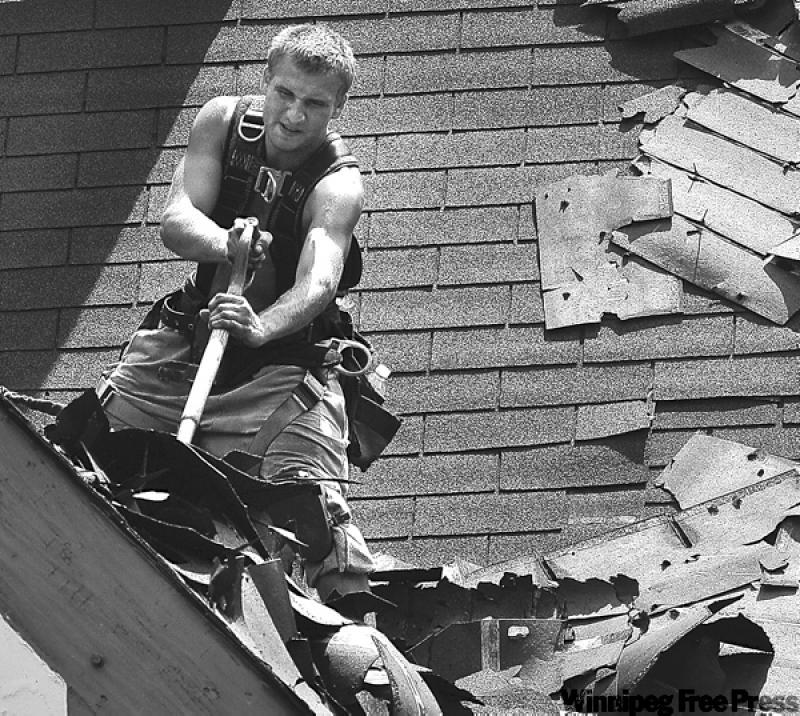QUESTION: I would like to ask for your advice on how to safely clean shingles. The Manitoba Maple tree in my neighbours' yard has left a black residue on the shingles on my garage, as well as on the garden border stones. The overhanging branches have now been removed. I would like to restore the garden stone to its original colour, but my main concern is how to clean the shingles without damaging the granular surface. Any advice would be appreciated.
-- Maureen Grant, email
I have a new deck which is one foot off the ground. The ants are constantly crawling all over it. What do you suggest?
-- Theresa, email
ANSWER: While both of these questions emailed in by readers may be about issues that are difficult to solve, they are not necessarily important for proper maintenance of a home and are purely cosmetic or a nuisance in nature.
Despite the common practice of home inspections in our area for almost two decades, many homeowners still don't understand the role of home inspectors in relation to the purchase of a home. I chose to answer these questions to help illustrate that the role of home inspectors is to address maintenance and performance issues and not worry about minor or cosmetic concerns.
The role of the home inspector in the purchase of a pre-owned home is to conduct a limited visual inspection of the condition of all the major systems in the home. The purpose of the inspection is to identify and report on any system that is in need of repair or replacement.
This is directed specifically to anything that is deemed to be a "major defect" or "in need of immediate repair", but also may include items that are less urgent. These items often include general maintenance issues that can help prevent moisture intrusion into the home or further deterioration to various components. This can include fixtures such as windows and doors, exterior grading, eavestroughs, roofing, plumbing, heating, electrical, and insulation. It may also include interior components such as hardwood and ceramic tile flooring if it is damaged. What is not part of the normal pre-purchase home-inspection process is evaluation of cosmetic or non-essential items such as wall coverings, paint, carpets, landscaping features, or other decorative features. The determination of the value or condition of these items is the responsibility of the purchaser, as these may impact the sale, but are not critical to the performance of the building.
These items should be readily visible to the purchaser and open to subjective rather than objective viewpoints. This also includes freestanding appliances such as washers and dryers, ranges and dishwashers, although some inspectors include inspection of these components at no additional charge.
I chose to highlight this issue because many individuals involved in the home-buying process are often confused and disconcerted when items are identified as defects during the course of a home inspection. Items that may seem like minor issues such as damaged hardware on windows or leaky plumbing drains may lead to much bigger problems if not immediately repaired. A window that does not close properly or a drain or faucet that constantly drips, without being detected, can lead to significant water damage and major repairs. While the cost of repairing these issues can be quite minor, the implications of neglect may be major expenses.
The inverse of this point are items that may be a major expense if upgraded or repaired, but do not affect the performance of the home. Deteriorated kitchen cabinets that may have worn finishes or peeling veneers may look awful and cost thousands of dollars to replace, but may be perfectly functional. Basements with old wall paneling, ceiling and carpets may be in need of serious updating, but are not a performance defect in the eyes of the inspector.
I am addressing this issue in relation to both of your questions to illustrate my point. Ants on a newly built wood deck may be a nuisance, but will not affect the performance in any way. In fact, the performance of the deck is vastly improved, as long as it is properly constructed. The ants are likely crawling all over the new deck because they are either attracted to something being emitted from the new wood or because construction of the deck has disturbed their previous home underneath. They are neither capable of harming the deck or the users, but may be a nuisance especially if they gain entrance into the home from a patio door opening onto this area.
As far as stains from tree sap on garage shingles or patio stones, I can think of nothing more superficial to illustrate my point about cosmetic issues versus performance. I don't know of anything safe to clean asphalt shingles, because they are not designed to be cleaned. Anything you use, other than water from a garden hose or a soft broom, may cause damage resulting in reduced performance or life expectancy. Also, some cleaners used on your patio stones may be toxic to the surrounding plants and grass, so I would avoid these as well.
In my opinion, these issues are purely cosmetic and not worth much concern. If you are bound and determined to remedy these items, you may want to consult someone like a popular West Coast celebrity home adviser who will recommend his own brand of miracle product that may or may not solve the dilemma.
Ari Marantz is the owner of Trained Eye Home Inspection Ltd. and the President of the Canadian Association of Home & Property Inspectors -- Manitoba (www.cahpi.mb.ca). Questions can be emailed or sent to: Ask The Inspector, P. O. Box 69021, #110-2025 Corydon Ave., Winnipeg, MB. R3P 2G9. Ari can be reached at (204) 291-5358 or check out his website at www.trainedeye.ca.
trainedeye@iname.com




